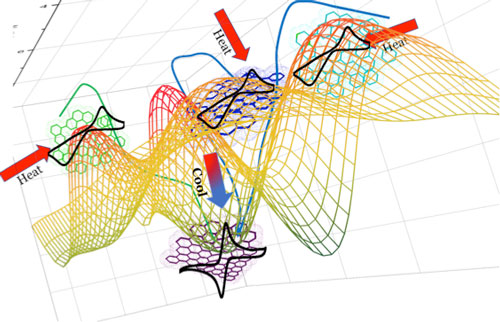| Jan 08, 2019 | |
Research highlights sustained electron transport kinetics of graphites for at least 9 weeks |
|
| (Nanowerk Spotlight) Research published in ACS Applied Nano Materials ("Thermal Modification of Graphite for Fast Electron Transport and Increased Capacitance") reports a breakthrough solution to the oxidation-induced sluggish electron transport in graphite (and even graphene). | |
| It is this sluggish electron transport kinetics – also known as aging – that has hindered the application of graphene, for example, as transparent photodiode sensors in optoelectronics, graphites for effective use as oxygen reducing agents in fuel cells and so many other applications that involve fast heterogeneous electron transport and even increased capacitance. | |
| With this discovery, these applications are now possible even on commercial scales. This discovery solves more than a 50-year quest for the solution to oxidation induced sluggish electron transport. | |
| The work was performed with eight different graphites from different graphitic strata by thermally treating them in air and allowing them to cool slowly. | |
| The research team (O. Charles Nwamba, Jean’ne M. Shreeve and D. Eric Aston from the University of Idaho, while David N. McIlroy, Elena Echeverria, and Aaron Austin are from the Oklahoma State University) surmised that to obtain limited aging or continuously fast heterogeneous electron transport for at least 64 days (unlike minutes to hours that is currently obtainable), the electronic properties of the graphites are tuned to have higher polycrystalline properties in such a way to permit π electron delocalization from one crystalline lattice to another, with minimum perturbation from oxygen or even hydrocarbon interactions. | |
 |
|
| The folding funnel concept is used to describe the transitioning of both the structure and electronics of different graphite moieties on thermal treatment. Different graphite occupy different energy landscapes as represented by the various local minimum and possess sluggish heterogeneous electron transfer (HET) kinetics as depicted by the quasi-reversible cyclic voltammograms (CVs) in ferri-ferrocyanide redox couple. When thermally treated in air and allowed to gradually cool, these graphite structures explore various conformations (contours) via same or similar pathways (various shades of arrows) to arrive at similar local minimum with similar structural and electronic entities . These structures now exhibit fast HET (reversible CV) that is sustained for over 9 weeks. (Image courtesy of the researchers) | |
| The researchers argued, from their data, that to obtain this π electron delocalization across various sites of a now higher order polycrystalline state, the sigma (σ) bonds, which represents point or Coulombic charges will need to be tuned down with an accompanying increase in the density of states at the Brillouin zone. | |
| In other words, the electronic nature of the materials plays the more important role to the surface structure such as edge sites, which some have postulated to be the dominant factor for fast electron transport. | |
| Another interesting point highlighted by this research, which also confirms some recent research results, is that the water contact angle "strongly reflects consistency with surface functional constituencies when they also correlate with electronic structural effects" rather than just reflecting only surface properties. | |
| Another highlight is that capacitance building arises from sub-surface oxygen, rather than surface bound oxides as previously thought. | |
| Based on attained and sustained fast heterogeneous electron transport kinetics, the thermal treatment protocol could be used for materials with applications hinging on fast electron transfer and/or increased capacitance, such as sensing, electro-oxidative reactions in water purification, batteries and supercapacitors, catalysis, oxygen reduction for fuel cells, HPLC detectors, and semiconductors. | |
|
Provided by the University of Idaho as a Nanowerk exclusive
|
|
|
Become a Spotlight guest author! Join our large and growing group of guest contributors. Have you just published a scientific paper or have other exciting developments to share with the nanotechnology community? Here is how to publish on nanowerk.com. |
|
